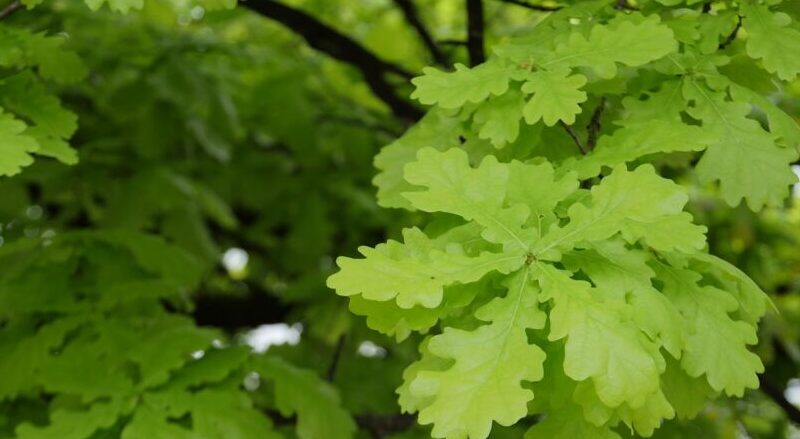Before you eat oak, you have to find one! Fortunately it is very easy to recognize. Its bark is very rough and its branches are often tortuous. Its lobed leaves are impossible to confuse. Everyone also knows the acorn, decorated with its cap: the cupule.
Contents
Are oak leaves edible?
The very young leaves of the oaks are edible. The tannins have medicinal virtues. The leaves are used against irritations, inflammation of the throat, mouth ulcers.
They are also taken in decoction: use a handful per liter, boil lightly for 10 minutes then let infuse for 10 minutes. You can use it as a gargle for sore throats, or as an enema for smelly white discharge in women.
You can also make salads with the young shoots of leaves. But you should not delay, after a week the leaves are no longer edible.
However, when we talk about eating oak, we are mostly talking about the acorns. The leaves are only used to make infusions.
Are oak acorns edible?
Oak acorns can be picked from the ground or from trees. On the ground, you can be sure that it is ripe. You have to remove the skin and taste a piece. It can have a taste close to raw chestnut. Acorns with little tannin will take less time to prepare. Acorns are very nutritious, they contain B vitamins and macro-nutrients: lipids, carbohydrates and proteins.
They are twice as caloric as chestnuts, which contain 98% carbohydrates. It is a delicious fruit but once the tannins are removed. It is sweet and soft. It can also be dried to obtain a coffee substitute, by roasting it in the oven. Acorn coffee is also available commercially.
The acorns fall in September and are ready to be harvested. As long as they have not been eaten by worms, they can be harvested all winter. They are edible but full of tannins that are bitter and dry the mouth. To remove these tannins, the acorns must be boiled for 20 minutes in five different waters. Once prepared, the acorns are very nutritious.
Oak coffee can also be made. You just have to roast acorns for 45 minutes in the oven at 302°F and grind them.
How to cook and eat acorns and oak leaves?
The oak tree produces bark and leaves with medicinal properties. Its acorns are edible and have a taste similar to chestnuts. They were consumed for thousands of years by our ancestors. Because of its abundance and nutritional qualities, it is an ideal food!
In many traditions, the oak was considered a sacred tree. For the Celts, it was a temple, and in other mythologies, the symbol of a door opening on both ends of the year, thus closing the annual cycle. It is also known for its robustness and longevity – specimens have been seen to be 1000 years old and up to 45 meters high. The most common oaks are the pedunculate and sessile oaks, from the fagaceae family.
This tree grows very slowly and is resistant to disease. The adult oak is very generous and produces about 50,000 fruits, nutritious and rich in many nutritional qualities.
How to prepare and eat acorns?
Before eating the acorns, it is essential to remove their tannins. This step takes more or less time depending on the variety of oak, some acorns containing more than others.
To extract the tannins
- Slit the outer shell of the acorns and cook them in boiling water for 15 minutes. Remove the thick skin and the thin film surrounding the two cotyledons.
- Crush them into coarse pieces and cook them for about 20 minutes.
- Repeat the operation, renewing the water until they have lost their bitterness.
- The cooking water is brown, but becomes clear again when there is no tannin, which is a sign that the acorns are ready to be eaten. Two waters are sufficient for most varieties.
Acorns can be eaten as is. Although they are blander than chestnuts, they can be seasoned to enhance their flavor. Simply add olive oil, salt, and possibly other condiments.
Juniper, for example, goes particularly well with its flavor. They can be candied in sugar like marrons glacés, made into a coffee substitute, added to a soup, or eaten roasted, like chestnuts.
Another solution is to turn them into flour. To do this, simply dry them in the oven, then grind them.
Finally, it is possible to store acorns in winter in a cool and dry place, and wait for their germination in spring. Germination makes them more digestible, reduces their bitterness, and they will be richer in vitamins.
What other tree leaves can you eat?
Let’s not forget the chestnut trees, which were planted to avoid famines. And then the hazelnut trees, the walnut trees. The ash tree also has immense virtues against joint pain. It has anti-inflammatory and analgesic properties.
It helps the kidneys to eliminate. It is recommended for the prevention of kidney stones, arthritis, osteoarticular pains, rheumatism. It is an antioxidant plant. To use in infusion of sheets for the articulations.
The flowers of elderberry have softening and anti-inflammatory virtues. As for the Gingko Biloba, this Chinese tree known as fossil, nicknamed the forty-ecu tree or the thousand-ecu tree, its fruit is edible in small quantities. Asians eat the roasted almond, which is very popular in Korea.
It, too, has a life expectancy of 1,000 years and is said to have survived at least 5,000 years despite drought, the ice age and even the Hiroshima nuclear disaster.








